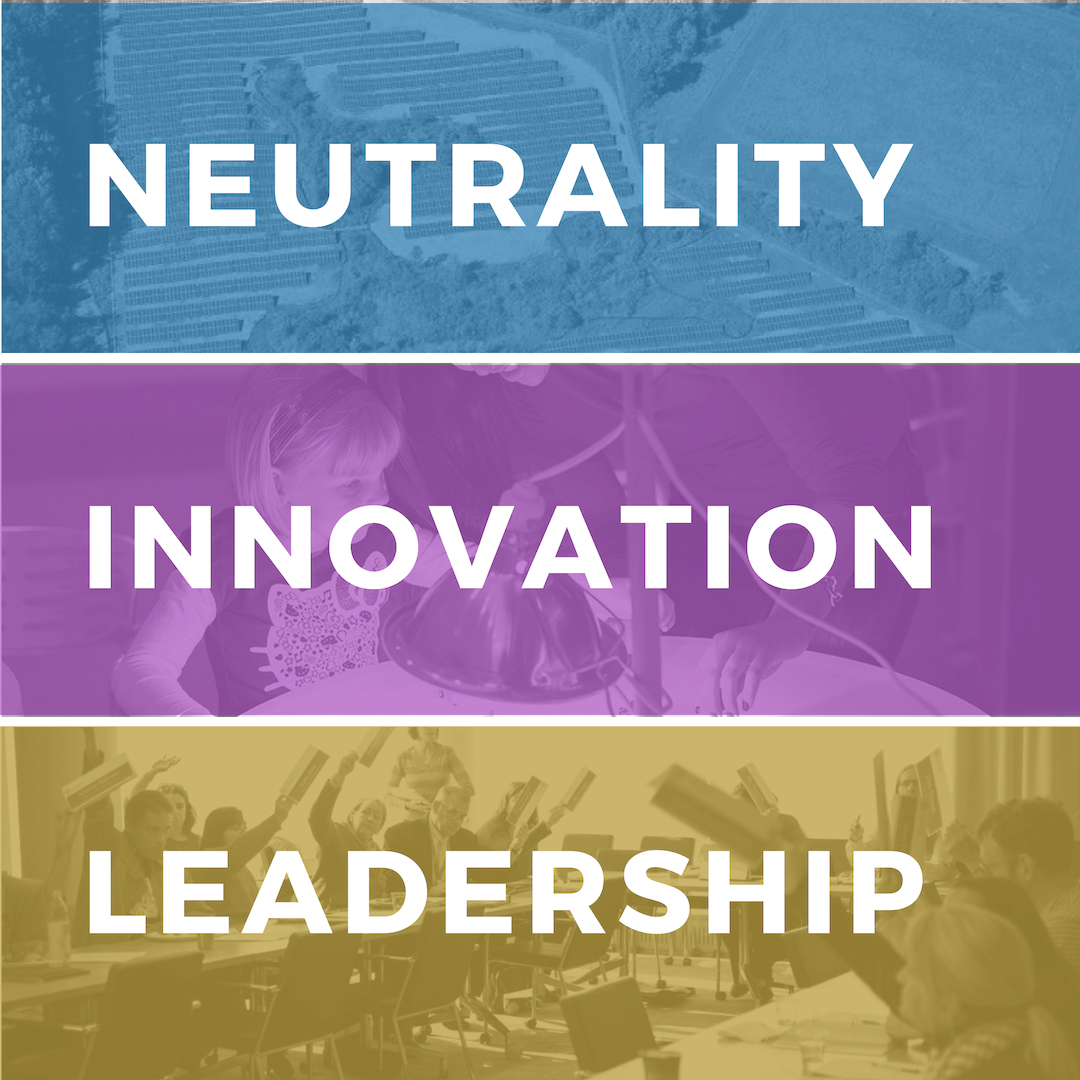About the Plan
The Climate Action Plan is the University's overarching strategy for moving to a low-carbon future and demonstrating climate leadership through neutrality, innovation, and leadership.
Our Approach
The path to carbon neutrality for Cornell University is comprised of three, interdependent pillars of action. They help reduce our campus emissions and harness our academic and land-grant educational mission.
Neutrality
Reduce Cornell University's campus carbon emissions to zero by 2035 from our 2008 baseline.
Innovation
Create a living laboratory for
low-impact behaviors and climate change education and research.
Leadership
Lead by example, on campus, and beyond by leveraging partnership and knowledge sharing.
Everyone is involved.
The plan's strategies bring together students, faculty, and staff on matters of research, education, campus stewardship, and outreach - fostering a sense of community and preparedness for the future.
To do this, we first aspire to advance best practices in our own facilities, then effect global impact by sharing solutions, reporting publicly and transparently, partnering in local and state collaborations, and using our campus as a living laboratory for climate innovation.
More Information
Explore these sections to learn more about our history, key facts, and more.
Key Facts
Cornell University's target date for carbon neutrality is 2035.
-
The CAP applies to the Ithaca, NY campus.
-
2008 is the baseline year from which Cornell measures progress towards neutrality, and measures emissions in line with the Second Nature Carbon Commitment and World Resources Institute GHG Protocol.
-
The Cornell Board of Trustees approved the GHG reduction goal.
-
The plan is intended to enhance the university’s core mission while cutting net carbon emissions.
Implementation
Implementation of the CAP is the responsibility of the entire campus community. Real change is only possible through the work of campus partners at every level working together to create a low-carbon, resilient, and climate-adapted future.
Responsibilities
Some responsibilities are outlined in the 2013 Climate Action Plan Update.
Cornell's sustainability governance groups, Campus Sustainability Office, and key departments share oversight of actions and progress.
Why Carbon Neutrality
It's imperative. Here’s what the evidence is telling us: the climate of our planet is warming at an alarming rate and human activities are the cause. How to reverse this trend poses an immense challenge, and the imperative to change our course is here, now. As one of the world’s leading universities, Cornell University has a pivotal role to play. We have a responsibility both to reduce our contribution to climate change and to generate solutions to address the mounting impacts on our planet.
We must take action. For 150 years Cornellians have taken on the world’s issues as our direct challenges. We are committed to find new solutions to complex problems. What has kept Cornell at the forefront of the sustainability movement is our institution-wide commitment to focus our collective strengths in education, research, and public engagement toward one of humanity’s greatest challenges – climate change. We put this commitment into action every day, in ways large and small.
We're at a crossroads. We have made great progress, but to move ahead we need to change the way we do things. Early successes were achieved through projects that yielded a return on capital investment. Current economic realities, including cheap natural gas and the absence of a price for carbon pollution, mean that further significant progress will be more difficult and will require making key actions institutional priorities to benefit Cornell’s academic mission and achieve carbon neutrality. Working collectively is the answer.
We can achieve our goal. Cornell’s updated Climate Action Plan prioritizes the steps toward campus climate neutrality. Academic and operational innovations are essential to our success. As we work together to create a living laboratory for climate-smart behaviors, education, and research, we are engaging the Cornell community in constructive conversations about how best to move forward. These conversations involve faculty across disciplines, students across colleges, staff across campus, and university leadership. The plan incorporates input from key project leaders, as well as ideas and contributions from students, faculty, and staff. There are ways for everyone to get involved.
History
2007: Cornell Joins the Carbon Commitment
In 2007, Cornell University became one of the first fifty signatories and the first Ivy League institution to sign the American College & University Presidents' Climate Commitment, now called the Carbon Commitment. Over 600 campuses in the U.S. participate in the commitment, sharing annual greenhouse gas progress and climate action plans publicly and transparently.
2009: First Climate Action Plan
After signing the commitment, members of the Cornell community worked to develop the first Climate Action Plan released in 2009. The CAP was written by Cornell faculty, students, and staff with funding from the state energy authority, NYSERDA.
2013: Roadmap Update
Cornell releases a significant update to the original CAP.
2014: CAP Moves Online
The CAP becomes a "living document" online.
2014: Goal Acceleration
The original goal for carbon neutrality was 2050, which was accelerated to 2035 after the Acceleration Working Group produced a report in 2014 calling for a neutrality date aligned with leading climate science and global mitigation targets.
2016: Options Report
The Senior Leaders Climate Action Group releases Options for a Carbon Neutral Campus to identify the best path forward for heating and cooling the campus with zero carbon.

